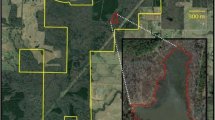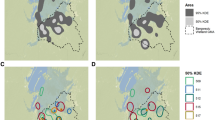Abstract
Conservation efforts require detailed knowledge of a species' habitat use and movements about the landscape. We radio-tracked sympatric congeners, the Copperbelly Water Snake (Nerodia erythrogaster neglecta) and the Northern Water Snake (Nerodia sipedon sipedon) in northwestern Ohio and southern Michigan, USA, to investigate differences in the use of wetland and upland habitats between species.Nerodia erythrogaster neglecta used twice as many wetlands (4.1±0.4) asN. s. sipedon (2.1±0.3), moved between these wetlands three times more often (9.1±1.9 times) thanN. s. sipedon (2.8±1.0 times), and moved to small wetlands seven times more often (3.6±0.7 times) thanN. s. sipedon (0.5±0.3 times). Nearly 30% ofN. e. neglecta locations were in uplands, sometimes over 100 m from the nearest wetland. Less than 3% ofN. s. sipedon locations were in upland habitats, and all locations were <30 m from wetlands. We simulated the impact of small wetland loss and demonstrated thatN. e. neglecta would need to move longer than normal distances when traveling between wetlands after small wetlands are lost, whileN. s. sipedon would not. The northernmost populations ofN. e. neglecta are listed as federally threatened and state endangered in Ohio, Michigan, and Indiana;N. s. sipedon remains abundant in this region. Historic and current wetland losses in the midwestern United States may have severely impactedN. e. neglecta populations due to this species' high vagility and use of numerous wetlands. Protection and restoration of wetland landscapes are critical for the long-term persistence of many wetland-associated species, species, includingN. e. neglecta.
Similar content being viewed by others
Literature Cited
Bedford, B. L. 1999. Cumulative effects on wetland landscapes: links to wetland restoration in the United States and Southern Canada. Wetlands 19:775–788.
Bennett, D. H., J. W. Gibbons, and J. C. Franson. 1970. Terrestrial activity in aquatic turtles. Ecology 51:738–740.
Brown, G. P. and P. J. Weatherhead. 2000. Thermal ecology and sexual size dimorphism in northern water snakes,Nerodia sipedon. Ecological Monographs 70:311–330.
Buhlmann, K. A. 1995. Habitat use, terrestrial movements, and conservation of the turtle,Deirochelys reticularia, in Virginia. Journal of Herpetology 29:173–181.
Buhlmann, K. A. and J. W. Gibbons. 1997. Imperiled aquatic reptiles of the Southeastern United States: historical review and current conservation status. p. 201–231.In G. Benz and D. Collins (eds.) Aquatic Fauna in Peril: the Southeastern Perspective. Southeast Aquatic Research Institute, Lenz Design & Communications, Decatur, GA, USA. Special publication 1.
Buhlmann, K. A. and J. W. Gibbons. 2001. Terrestrial habitat use by aquatic turtles from a seasonally fluctuating wetland: implications for wetland conservation boundaries. Chelonian Conservation and Biology 4:115–127.
Burke, V. J. and J. W. Gibbons. 1995. Terrestrial buffer zones and wetland conservation: a case study of freshwater turtles in a Carolina Bay. Conservation Biology 9:1365–1369.
Carpenter, C. C. 1953. A study of hibernacula and hibernating association of snakes and amphibians in Michigan. Ecology 34:74–80.
Coppola, C. J. 1999. Spatial ecology of southern populations of the Copperbelly Water Snake,Nerodia erythrogaster neglecta M.S. Thesis. Purdue University, Fort Wayne, IN, USA.
Cowardin, L. M., V. Carter, F. C. Golet, and E. T. LaRoe. 1979. Classification of wetlands and deepwater habitats of the United States. United States Fish and Wildlife Service, Washington, DC, USA.
Dahl, T. E. 1990. Wetland Losses in the United States 1780's to 1980's. United States Department of the Interior, Fish and Wildlife Service, Washington, DC, USA.
Dahl, T. E. and C. E. Johnson. 1991. Status and Trends of Wetlands in the Conterminous United States, Mid-1970's to Mid-1980's. United States Department of the Interior, Fish and Wildlife Service, Washington, DC, USA.
Deiner, R. A. 1957. An ecological study of the plain-bellied water snake. Herpetologica 13:203–211.
Dodd, C. K. 1992. Biological diversity of a temporary pond herpetofauna in north Florida sandhills. Biodiversity and Conservation 1:125–142.
Dodd, C. K. and B. S. Cade. 1998. Movement patterns and the conservation of amphibians in small, temporary wetlands. Conservation Biology 12:331–339.
Environmental Systems Research Institute. 1992. ArcView GIS. Version 3.2. ESRI, Inc. Redlands, CA, USA.
Gibbons, J. W. 1970. Terrestrial activity and the population dynamics of aquatic turtles. American Midland Naturalist 83:404–414.
Gibbons, J. W. 1986. Movement patterns among turtle populations: applicability to management of the desert tortoise. Herpetologica 42:104–113.
Gibbons, J. W., J. L. Green, and J. D. Congdon. 1983. Drought-related responses of aquatic turtle populations. Journal of Herpetology 17:242–246.
Gibbons, J. W., D. E. Scott, T. J. Ryan, K. A. Buhlmann, T. D. Tuberville, B. S. Metts, J. L. Greene, T. Mills, Y. Leiden, S. Poppy, and C. T. Winne. 2000. The global decline of reptiles, déjà vu amphibians. BioScience 50:653–666.
Gibbs, J. P. 1993. Importance of small wetlands for the persistence of local populations of wetland-associated animals. Wetlands 13: 25–31.
Haig, S. M., D. W. Mehlman, and L. W. Oring. 1997. Avian movements and wetland connectivity in landscape conservation. Conservation Biology 12:749–758.
Hanski, I. and M. E. Gilpin. 1991. Metapopulation dynamics: a brief history and conceptual domain. Biological Journal of the Linnean Society 42:3–16.
Harrison, S. 1991. Local extinction in a metapopulation context: an empirical evaluation. Biological Journal of the Linnean Society 42:73–88.
Herbard, J. J. and H. R. Mushinsky. 1977. Habitat use by five sympatric water snakes in a Louisiana swamp. Herpetologica 34:306–311.
Hyslop, N. L. 2001. Spatial ecology and habitat use of the Copperbelly Water Snake (Nerodia erythrogaster neglecta) in a fragmented landscape. M.S. Thesis. Purdue University, Fort Wayne, IN, USA.
Joyal, L. A., M. McCollough, and M. L. Hunter. 2001. Landscape ecology approaches to wetland species conservation: a case study of two turtle species in southern Maine. Conservation Biology 15: 1755–1762.
Kaiser, J. 1998. New wetlands proposal draws flak. Science 279:980.
Keck, M. B. 1998. Habitat use by semi-aquatic snakes at ponds on a reclaimed strip mine. Southwestern Naturalist 43:13–19.
Kingsbury, B. A. and C. J. Coppola. 2000. Hibernacula of the Copperbelly Water Snake (Nerodia erythrogaster neglecta) in southern Indiana and Kentucky. Journal of Herpetology 34:294–298.
MacArthur, R. H. and E. O. Wilson. 1963. An equilibrium theory of insular zoogeography. International Journal of Organic Evolution 17:373–387.
Marshall, J. 2002. Spatial ecology of the Eastern Massassauga Rattlesnake (Sisturus catenatus catenatus) in fen habitat. M.S. Thesis. Purdue University, Fort Wayne, IN, USA.
Madsen, T. and R. Shine. 1993. Costs of reproduction in a population of European adders. Oecologia 94:488–495.
Morreale, S. J., J. W. Gibbons, and J. D. Congdon. 1984. Significance of activity and movement in the yellow-bellied slider turtle (Pseudemys scripta). Canadian Journal of Zoology 62:1038–1042.
Naugle, D. E., K. F. Higgins, S. M. Nusser, and W. C. Johnson. 1999. Scale-dependent habitat use in three species of prairie wetland birds. Landscape Ecology 14:267–276.
Naugle, D. E., K. F. Higgins, M. E. Estey, R. R. Johnson, and S. M. Nusser. 2000. Local and landscape-level factors influencing black tern habitat suitability. Journal of Wildlife Management 64:253–260.
Naugle, D. E., R. R. Johnson, M. E. Estey, and K. F. Higgins. 2001. A landscape approach to conserving wetland bird habitat in the prairie pothole region of eastern South Dakota. Wetlands 21:1–17.
Pruitt, S. and J. Szymanski. 1997. Endangered and threatened wildlife and plants; determination of threatened status for the northern population of the copperbelly water snake. Federal Register 62: 4183–4193.
Pulliam, H. R. 1988. Sources, sinks, and population regulation. American Naturalist 132:652–661.
Reinert, H. K. and D. Cundall. 1982. An improved surgical implantation method for radio-tracking snakes. Copeia 1982:702–705.
Seigel, R. A., J. W. Gibbons, and T. K. Lynch. 1995. Temporal changes in reptile populations: effects of a severe drought on aquatic snakes. Herpetologica 51:424–434.
Semlitsch, R. D. 1998. Biological delineation of terrestrial buffer zones for pond-breeding salamanders. Conservation Biology 12: 1113–1119.
Semlitsch, R. D., D. E. Scott, J. K. Pechmann, and J. W. Gibbons. 1996. Structure and dynamics of an amphibian community: evidence from a 16-year study of a natural pond. p. 217–248.In M. Cody and J. Smallwood (eds.) Long Term Studies of Vertebrate Communities. Academic Press, San Diego, CA, USA.
Semlitsch, R. D. and J. R. Bodie. 1998. Are small, isolated wetlands expendable? Conservation Biology 12:1129–1133.
Shine, R. and M. Fitzgerald. 1996. Large snakes in a mosaic rural landscape: the ecology of carpet pythonsMorelia spilota (Serpentes: Pythonidae) in coastal eastern Australia. Biological Conservation 76:113–122.
Snodgrass, J. W., J. W. Ackerman, A. L. Bryan, and J. Burger. 1999. Influence of hydroperiod, isolation, and heterospecifics on the distribution of aquatic salamanders (Siren andAmphiuma) among depression wetlands. Copeia 1999:107–113.
Snodgrass, J. W., M. J. Komorowski, A. L. Bryan, and J. Burger. 2000. Relationships among isolated wetland size, hydroperiod, and amphibian species richness: implications for wetland regulations. Conservation Biology 14:414–419.
SPSS. 1999. Advances models. Version 10.0 for Windows. SPSS, Chicago, IL, USA.
Tiebout, H. M. and J. R. Cary. 1987. Dynamic spatial ecology of the water snake,Nerodia sipedon. Copeia 1987:1–18.
Weatherhead, P. J. and F. W. Anderka. 1984. An improved radio transmitter and implantation technique for snakes. Journal of Herpetology 18:264–269.
Willard, D., M. Leslie, and R. B. Reed. 1990. Defining and delineating wetlands. p. 111–118.In G. Bingham, E. Clark, L. Haygood and M. Leslie (eds.) Issues in Wetlands Protection. The Conservation Foundation, Washington DC, USA.
Author information
Authors and Affiliations
Rights and permissions
About this article
Cite this article
Roe, J.H., Kingsbury, B.A. & Herbert, N.R. Wetland and upland use patterns in semi-aquatic snakes: Implications for wetland conservation. Wetlands 23, 1003–1014 (2003). https://doi.org/10.1672/0277-5212(2003)023[1003:WAUUPI]2.0.CO;2
Received:
Revised:
Accepted:
Issue Date:
DOI: https://doi.org/10.1672/0277-5212(2003)023[1003:WAUUPI]2.0.CO;2




